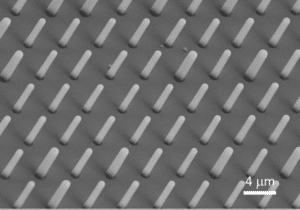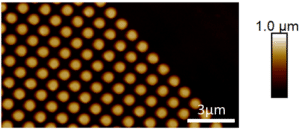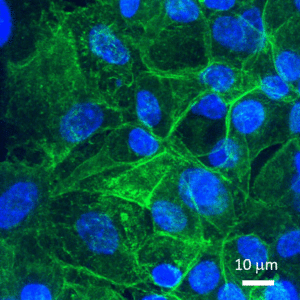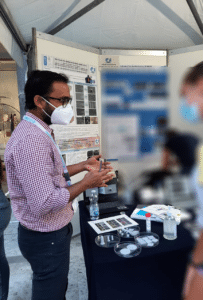This is the website of the Marie Skłodowska-Curie Action (MSCA) Individual Fellowship Project BIOIMD (‘Self-powered implantable medical devices’, grant agreement ID: 896811) carried out by Dr. Sujoy Kumar Ghosh (MSCA beneficiary postdoctoral fellow) and Dr. Luana Persano (coordinator) at CNR-Nanoscience Institute (NEST Laboratory) in Pisa, Italy.
Novel implantable medical devices (IMDs) allow the monitoring or detection of diseases inside the human body, yet the challenge is that these devices need to be supplied with continuous power. The implantable batteries suffer from limited lifetime and maintenance problems, and they require periodic replacement through surgery. Scavenging energy from biomechanical sources using piezoelectric devices presents a smart strategy since they can harvest electric supply from the inexhaustible motions of organs such as the heart, lungs and diaphragm. The focus of the EU-funded BIOIMD project is to develop high-performance piezoelectric polymer-based biodegradable IMDs which can be accommodated by the body and finally resorbed without any toxicity.
The interaction between medicine and technology allows the development of new implantable medical devices (IMDs) to detect or monitor diseases inside the human body. The key challenge is to supply continuous power to the IMDs. Conventional strategy to use the implantable battery suffers from limited lifetime, maintenance problem, hazardous chemicals and requirement of periodic replacement through surgery which eventually increase patient health risk. In this context, scavenging electricity from biomechanical energy sources using piezoelectric energy harvester is a smart strategy for realizing self-powered implantable bioelectronics, since it can harvest electric energy from inexhaustible slight motions of organs such as heart, lungs, and diaphragm. In this regard, the devices should be flexible and at the same time biodegradable to avoid invasive removal surgery that can damage directly interfaced tissues. Despite recent achievements in self-powered electronic devices, there is still a tremendous need to develop an efficient self-powered IMD which only relies on safe medical materials. In this context, the focus of the project is to develop high performance natural piezo-electric polymer based biodegradable IMD which can be absorbed by the body after certain period of time without any adhere toxicity. In addition, we will emphasize on material science, underlying concepts in mechanics and associated engineering strategies in device construction. The key design strategies for the piezoelectric device based self-powered IMD will adopt interdisciplinary approach from materials science (nanopillar configurations), chemistry (organic bio-polymers processing), applied physics (modeling, theoretical simulation), engineering (IMD circuit design) and biology (device implantation). This collective concept suggests a promising future across a range of fields, particularly in biomedical engineering, nanoneurotechnology and next-generation wireless implantable biomedical device.
Sujoy Kumar Ghosh is Marie Skłodowska-Curie Individual Fellow. His research focuses on experimental and simulation-based piezo-, pyro-, ferro-, magneto-, and triboelectric energy harvesting devices, including their design and applications. He got the PhD in 2019 with a thesis on “Flexible Piezo- & Pyro-electric Energy Harvester for Self-powered Electronics: From Portable Gadgets to Healthcare Monitoring” at the Department of Physics, Jadavpur University, India. As post-doc research associate he joined the Ulsan National Institute of Science and Technology (UNIST), South Korea, from June 2019 to January 2021. He authored 45 peer-reviewed SCI papers and received several research awards.
Luana Persano is Director of Research at CNR-Nanoscience Institute. She has been Marie-Curie fellow at FORTH, Greece, and visiting scientist at Harvard University and University of Illinois. Her research interests include nano-manufacturing and lithographic processes on organics and nanocomposites semiconductors, nanophotonic devices, and electrospinning, as well as and the implementation of nanophotonic and piezoelectric devices based on them. She has authored more than 119 papers on peer-reviewed journals, and several invited seminars and talks in national and international conferences. She has served as a member of organizing committees, programme committees and session chair at several international conference. She has been awarded the “CNR-Start-Cup” award in 2010, “Start-cup Puglia” award in 2011 and the “Bellisario”award as Young Talent in Industrial Engineering in 2011. She has been founder and researcher of a CNR high-tech spin-off company.
NEST, the National Enterprise for nanoScience and nanoTechnology, is an interdisciplinary research and training centre where physicists, chemists and biologists investigate scientific issues at the nanoscale. This knowledge is exploited to develop innovative nanobiotechnological tools, nanoelectronic and photonic devices and architectures.
The NEST initiative comprises four distinct institutions: Scuola Normale Superiore, Istituto Italiano di Tecnologia, Consiglio Nazionale delle Ricerche and Scuola Superiore Sant’Anna. Although each institution has its own staff and administration (Laboratorio NEST of SNS, Center for Nanotechnology Innovation of IIT, the Istituto Nanoscienze of CNR, and Nanoplant of SSSA) facilities and activities are closely coordinated and scientists team up for specific scientific objectives regardless of their affiliation.
This concentration of efforts and flexibility allows NEST scientist to address a rather broad range of research activities that span from semiconductor/superconductor nanostructure design, growth and experimental investigation to single-molecule studies in live cells and tissues. Despite this broad scope, NEST scientists adopt a unified approach thanks to the close cultural integration of its multidisciplinary teams which is characteristic of nanoscience.
More information on the NEST Laboratory can be found at the website: https://www.laboratorionest.it/

Microfabrication. a. SEM of micropillars of polymer. b., c. Photograph of the same sample highlighting the patterned area, sample flexibility. and optical transparency.

SEM of polymer nanopillars with diameter 600 nm.

Atomic force microscopy image of polymer nanopillars for the BIOIMD device platform.

Cell culture used for viability experiments on our devices. Credit: Dr. I. Tonazzini.

Dr. Ghosh presenting project results at the the European Researchers’ Night event. Pisa, September 21, 2021.
All the foreground publications generated by BIOIMD have been made or will be made Open Access. The project is also mentioned in other (e.g. review papers or books), enhancing its overall visibility in the related scientific communities.
List of publications:
S.K. Ghosh, L. Persano, B. Mahanty, Designing piezo- and pyroelectric energy harvesters, Chapter 10, pages 267-293, 2022, in ‘Engineered Polymer Nanocomposites for Energy Harvesting Applications’, Eds. M.T. Rahul, S. Thomas, D. Rouxel, N. Kalarikkal, B. Ameduri, R. Balakrishnan. Elsevier Inc. DOI: 10.1016/C2020-0-01688-9.
L. Persano, S. K. Ghosh, D. Pisignano, Enhancement and Function of the Piezoelectric Effect in Polymer Nanofibers, Acc. Mater. Res. 2022, 3, 900–912, DOI: 10.1021/accountsmr.2c00073.
Istituto Nanoscienze
Consiglio Nazionale delle Ricerche
PEC: protocollo.nano@pec.cnr.it
Partita IVA 02118311006
Piazza San Silvestro 12
56127 Pisa, Italy
phone +39 050 509418
fax +39 050 509550
Istituto Nanoscienze Consiglio Nazionale delle Ricerche
Piazza San Silvestro 12, I
56127 Pisa
phone +39 050 509525/418
fax +39 050 509550
via Campi 213/A, I
41125 Modena 7
phone +39 059 2055629
fax +39 059 2055651″
| Cookie | Duration | Description |
|---|---|---|
| cookielawinfo-checkbox-analytics | 11 months | This cookie is set by GDPR Cookie Consent plugin. The cookie is used to store the user consent for the cookies in the category "Analytics". |
| cookielawinfo-checkbox-functional | 11 months | The cookie is set by GDPR cookie consent to record the user consent for the cookies in the category "Functional". |
| cookielawinfo-checkbox-necessary | 11 months | This cookie is set by GDPR Cookie Consent plugin. The cookies is used to store the user consent for the cookies in the category "Necessary". |
| cookielawinfo-checkbox-others | 11 months | This cookie is set by GDPR Cookie Consent plugin. The cookie is used to store the user consent for the cookies in the category "Other. |
| cookielawinfo-checkbox-performance | 11 months | This cookie is set by GDPR Cookie Consent plugin. The cookie is used to store the user consent for the cookies in the category "Performance". |
| viewed_cookie_policy | 11 months | The cookie is set by the GDPR Cookie Consent plugin and is used to store whether or not user has consented to the use of cookies. It does not store any personal data. |